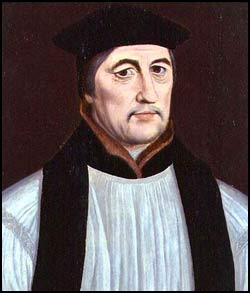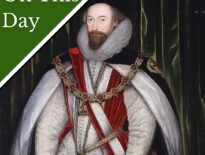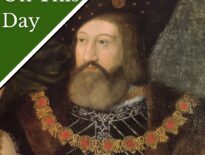 On this day in Tudor history, 23rd August 1553, just over a month after Mary I had been proclaimed queen, Stephen Gardiner, Bishop of Winchester, was made Lord Chancellor. Not bad for a man who'd recently been released from prison!
On this day in Tudor history, 23rd August 1553, just over a month after Mary I had been proclaimed queen, Stephen Gardiner, Bishop of Winchester, was made Lord Chancellor. Not bad for a man who'd recently been released from prison!
Here are some facts about Stephen Gardiner, a man known as "Wily Winchester":
- His birthdate is unknown, but he came from Bury St Edmunds in Suffolk and his father was William Gardiner (some say John Gardiner), a cloth merchant and a mercenary hired during the War of the Roses.
- Gardiner studied at Trinity Hall, Cambridge. He received the degree of Doctor of Civil Law in 1520 and of Canon Law in 1521.
- In his youth, he met the famous humanist scholar Erasmus in Paris.
- Following his studies, Gardiner worked for Cardinal Thomas Wolsey as a secretary.
- He met Henry VIII for the first time in 1525 at The More in Hertfordshire for the signing of the Treaty of the More between the King and Francis I of France. Two years later, in 1527, Gardiner and Sir Thomas More worked as commissioners in arranging, with the French ambassadors, a treaty to obtain support for an army against the Holy Roman Emperor, Charles V, in Italy.
- In 1526, Gardiner was appointed Archdeacon of Taunton.
- In 1527, Gardiner accompanied Wolsey on a diplomatic mission to France to gain Francis I's support for the annulment of Henry VIII's marriage to Catherine of Aragon.
- In 1528, as Gardiner was an expert on canon law, he was sent to Italy with Edward Foxe, the provost of King's College, Cambridge, to secure a decretal commission from the pope which would allow Cardinal Wolsey to rule on the validity of the king's marriage without appeal to Rome. The mission was unsuccessful because Pope Clement VII had recently been imprisoned by Emperor Charles V's troops and so was wary of offending the emperor, who was Catherine of Aragon's nephew. The pope did, however, grant a general commission to allow Cardinal Wolsey to try the case in England with the papal legate, Cardinal Campeggio.
- From 1529-1531, Gardiner was Archdeacon of Norfolk.
- In 1531, he became Archdeacon of Leicester and was also rewarded with the office of Bishop of Winchester after successfully procuring a decision from the University of Cambridge on the unlawfulness of a man marrying his dead brother's wife.
- In 1532, Gardiner offended Henry VIII after he was involved in preparing the “Answer of the Ordinaries”, a reply to the “Supplication Against the Ordinaries”.
- In May 1533, Gardiner assisted the Archbishop Thomas Cranmer in pronouncing the marriage between Henry VIII and Catherine of Aragon null and void.
- In 1535, he was one of the bishops asked to vindicate Henry VIII’s new title “Supreme Head of the Church of England”, something which he did by writing his treatise De vera obedientia, in which he argued that rulers were entitled to supremacy in their own country’s churches, and that the pope had no legitimate power over other churches.
- Between 1535 and 1539, Gardiner was often away on diplomatic missions for the king.
- In 1539 Gardiner helped to prepare “The Six Articles”, which reaffirmed the traditional Catholic doctrine on transubstantiation, clerical celibacy, the vow of chastity, the withholding of the cup from the laity at communion, private masses and auricular confession.
- In 1543, Gardiner was involved in the Prebendaries' Plot against Archbishop Cranmer, along with his nephew, Germain Gardiner. The plot failed when the king supported Cranmer, but Gardiner survived, although his nephew, the scapegoat, was executed for treason.
- In 1546, Gardiner, along with Lord Chancellor Thomas Wriothesley, attempted to turn the king against his sixth wife, the Reformist Catherine Parr. The plot failed when Catherine managed to reconcile with the king.
- Following Henry VIII's death in 1547 and the accession of Edward VI, Gardiner was imprisoned, first in Fleet and then in the Tower of London, for his opposition to the religious changes being made.
- In 1553, following the accession of the Catholic Mary I, Gardiner was released, restored to his bishopric and made Lord Chancellor.
- On 1st October 1553, Gardiner crowned Mary queen in a ceremony at Westminster Abbey.
- He helped his queen restore Catholicism and overturn the annulment of her parents' marriage, making her legitimate.
- Gardiner was instrumental in the marriage negotiations between Mary and Philip II of Spain, and he presided over their wedding ceremony at Winchester Cathedral on the 25th July 1554.
- In May 1555, Gardiner carried out his last diplomatic mission to France, to promote peace, a mission that was not successful, and in October 1555 he opened Parliament.
- Gardiner died on 12th November 1555. It is said that as he lay dying, the story of the Passion was read to him, and that his dying words, after hearing of the denial of Peter, were “Erravi cum Petro, sed non flevi cum Petro”, “Like Peter I have erred, unlike Peter I have not wept”, an allusion to his weakness during the reign of Henry VIII.
- Gardiner was laid to rest at Winchester Cathedral in what is now known as the Bishop Gardiner Chantry Chapel.
Also on this day in Tudor history...



Leave a Reply